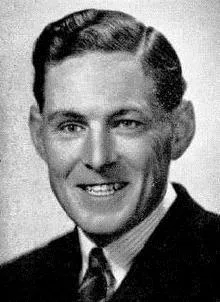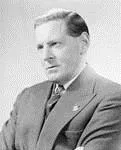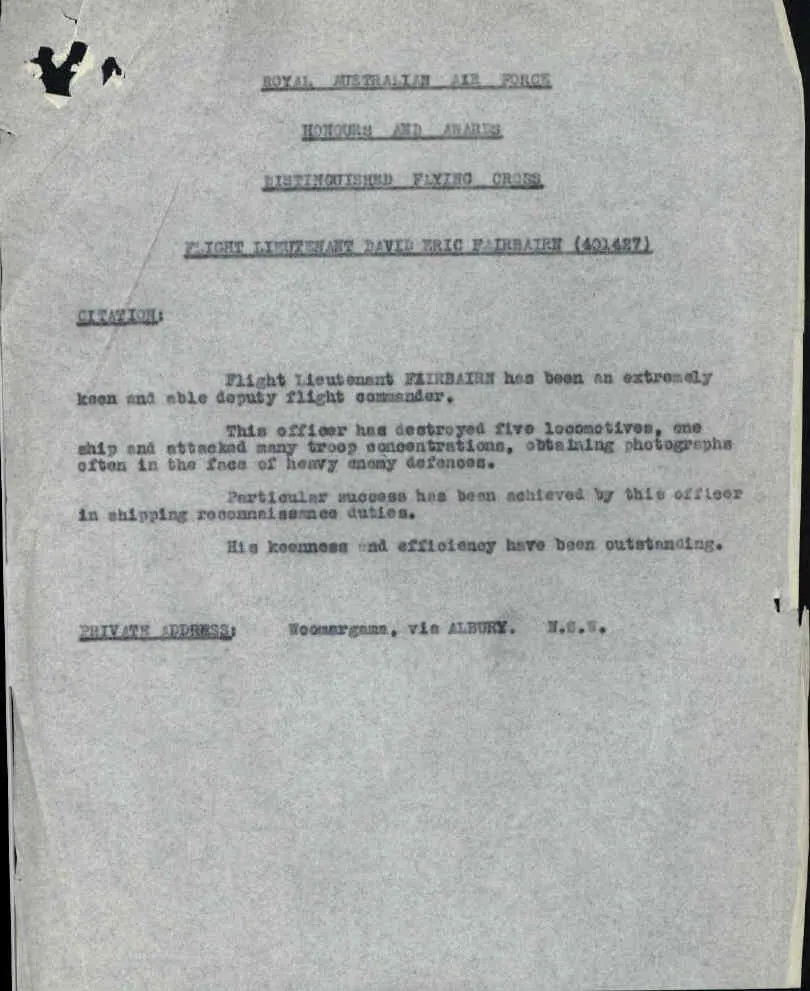FLTLT Sir David Eric Fairbairn 401427
KBE, DFC



| Squadron/s | 79 SQN 140 SQN RAF |
| Rank On Discharge/Death | Flight Lieutenant (FLTLT) |
| Mustering / Specialisation | Pilot |
| Date of Birth | 03 May 1917 |
| Date of Enlistment | 03 Feb 1942 |
| Contributing Author/s | Vince Conant, 2014 The Spitfire Association |
During World War II, he served in the 21st Light Horse Riverina Regiment from 1939 to 1941 and joined the Royal Australian Air Force in 1941. He served both in Britain, where he located the first V-1 flying bomb launching site, and in the New Guinea campaign. In 1945 he was badly wounded and discharged with the rank of Flight Lieutenant. Fairbairn had been awarded the Distinguished Flying Cross in 1944.
Discharged 21st January 1945 as a Flight Lieutenant from 79 squadron.
Fairbairn, Sir David Eric (1917–1994)
by John Farquharson
Sir David Eric Fairbairn, who died on Wednesday, was a quiet, earnest man whom a parliamentary colleague once described as "true blue — a gentleman in the conservative sense".
But to the surprise of his colleagues he once dropped a bombshell when he announced that he would not serve in any Cabinet headed by John Gorton and that he would challenge for the leadership of the Parliamentary Liberal Party.
It followed the 1969 election. Although the Coalition won, the result was narrower than expected. Even before the poll there had been rumblings, both within the Government's ranks and in the electorate at large, about aspects of John Gorton's prime ministerial style.
That was the atmosphere in which David Fairbairn made his audacious leadership move, startling the whole parliamentary membership. In the event, his challenge failed. John Gorton retained the leadership and David Fairbairn came last in the ballot after Billy McMahon, under whom he later served in Cabinet, firstly as Education Minister and then as Defence Minister.
The question that everyone was asking at the time was: Why did this quiet gentleman politician make this surprise move? Wal Fife, a colleague who had always been very close to him and who succeeded him in his seat of Farrer, suggested that it came down to the fact that David Fairbairn was a man with a proper sense of duty — the sort of man who goes into public life purely because he sees it as his duty and for no other reason.
Because of his deep concern for the Liberal Party, the Government and the nation, he saw it as his duty to risk all in an attempt to bring about a change which he saw as necessary at the time. But the way he went about it was typical of the man. He arrived at his decision without an open row with John Gorton. Rows were not his line. It was also typical that he announced his challenge with a formal, written statement, with none of the fanfare of media conferences and TV cameras. He did what he felt should be done and let it go at that. For he was not ambitious in the driving sense! He was shy, quiet and polite, did not seek controversy, but was capable of looking after himself when embroiled in it, as every politician inevitably is at some point or other.
Without being overly pushy, he nevertheless managed to carve out a fairly distinguished career after entering Parliament for the NSW seat of Farrer, based on the border city of Albury, at the 1949 election. He was one of the waves of ex-servicemen who swelled the ranks of the Liberal Party during the Menzies era.
Having regard to his family background, it was not surprising that David Fairbairn should turn to politics when the opportunity presented itself after World War II. He had been born on March 3, 1917, at Claygate, Surrey, England, into a distinguished Australian family. His great-grandfather, arriving in Australia in 1839, had been a pioneer of the canned-and frozen-meat industry. Both his grandfathers — Edmund Jowett and Sir George Fairbairn — were in the first Federal Parliament, and his uncle, James Fairbairn, was the Minister for Air in the Menzies Government who was killed in an air crash between Canberra and Queanbeyan in 1940. (The Fairbairn Memorial now marks the spot).
After being educated at Geelong Grammar School, he went on to Jesus College, Cambridge, graduating with an arts degree. He rowed in the Cambridge eight two years in succession, 1937 and 1938. He took over his pastoral property, Dunraven, at Woomargama, near Albury, in 1939. From 1939 to 1941 he served in the 21st Light Horse (Riverina) Regiment until he enlisted in the RAAF. He served in the General Duties branch in England and New Guinea and was badly wounded. He was awarded a DFC and discharged in 1945 with the rank of flight lieutenant.
When he first entered Parliament he continued to live on his family property but later also had a property, Hill Station, where the Hume industrial area now flourishes, before setting up home in Canberra itself.
He first came into the Menzies ministry in August 1962 as Minister for Air, retaining that portfolio until after the 1963 election and was appointed Minister for National Development in June 1964. He was Leader of the House from January to December 1966. From March until August 1971 he was Minister for Education and Science and from then until December 1972 he was Minister for Defence. For several months in 1963 he acted as Minister for Supply during the absence of Allan (now Sir Allan) Fairhall and for a month in 1971 he filled in for Senator Bob Cotton as acting Minister for Civil Aviation.
During his 25 years' service as a Member of the House of Representatives, he held a wide range of appointments. As well as being a member of the Joint Committee on the ACT, he also served on the parliamentary Joint Committee on Foreign Affairs and did a stint as chairman of the Australian Immigration Planning Council.
When the Liberal-National parties Coalition went into opposition after Gough Whitlam won the 1972 election for the Labor Party, David Fairbairn remained on the front bench as shadow minister for national development until June 1974.
Throughout his political career, his wife, Ruth, who has had a long and abiding interest in politics, was a valuable aide and confidante.
After retiring from politics at the 1975 elections, it was not quite the end of his public career. Two years later he went to the Hague as Australian Ambassador for three years. Then it was retirement to the Canberra suburb of Yarralumla, but not from maintaining an active interest in political affairs, both nationally and internationally.
Though he once rated himself as prime ministership material because of his "30 years' experience of running a farm", the top job evaded him. He was in fact among the least known of Menzies' ministers. But for all that, and although he was undoubtedly the antithesis of the political infighter, he turned out to be a very good survivor indeed for a "gentleman politician." Died in Canberra June 1994.
Original publication - Canberra Times, 8 June 1994


